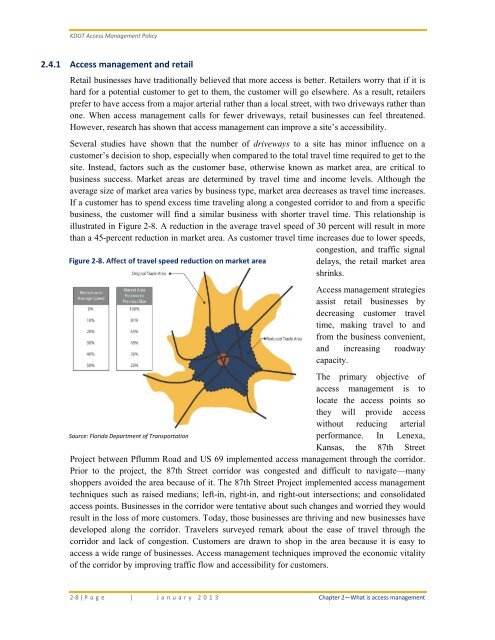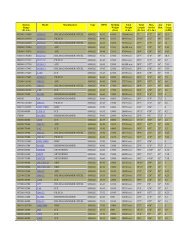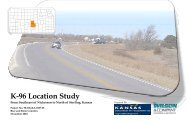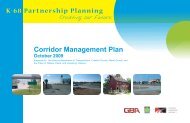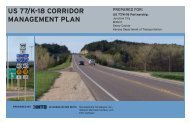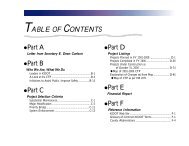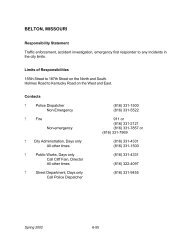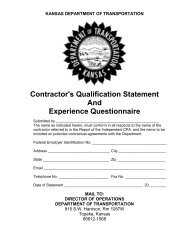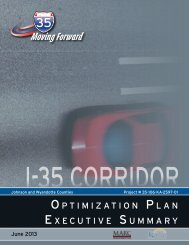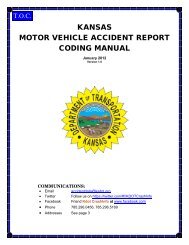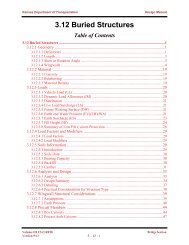Access Management Policy 2013 - Kansas Department of ...
Access Management Policy 2013 - Kansas Department of ...
Access Management Policy 2013 - Kansas Department of ...
Create successful ePaper yourself
Turn your PDF publications into a flip-book with our unique Google optimized e-Paper software.
KDOT <strong>Access</strong> <strong>Management</strong> <strong>Policy</strong><br />
2.4.1 <strong>Access</strong> management and retail<br />
Retail businesses have traditionally believed that more access is better. Retailers worry that if it is<br />
hard for a potential customer to get to them, the customer will go elsewhere. As a result, retailers<br />
prefer to have access from a major arterial rather than a local street, with two driveways rather than<br />
one. When access management calls for fewer driveways, retail businesses can feel threatened.<br />
However, research has shown that access management can improve a site’s accessibility.<br />
Several studies have shown that the number <strong>of</strong> driveways to a site has minor influence on a<br />
customer’s decision to shop, especially when compared to the total travel time required to get to the<br />
site. Instead, factors such as the customer base, otherwise known as market area, are critical to<br />
business success. Market areas are determined by travel time and income levels. Although the<br />
average size <strong>of</strong> market area varies by business type, market area decreases as travel time increases.<br />
If a customer has to spend excess time traveling along a congested corridor to and from a specific<br />
business, the customer will find a similar business with shorter travel time. This relationship is<br />
illustrated in Figure 2-8. A reduction in the average travel speed <strong>of</strong> 30 percent will result in more<br />
than a 45-percent reduction in market area. As customer travel time increases due to lower speeds,<br />
congestion, and traffic signal<br />
Figure 2-8. Affect <strong>of</strong> travel speed reduction on market area<br />
delays, the retail market area<br />
shrinks.<br />
<strong>Access</strong> management strategies<br />
assist retail businesses by<br />
decreasing customer travel<br />
time, making travel to and<br />
from the business convenient,<br />
and increasing roadway<br />
capacity.<br />
The primary objective <strong>of</strong><br />
access management is to<br />
locate the access points so<br />
they will provide access<br />
without reducing arterial<br />
Source: Florida <strong>Department</strong> <strong>of</strong> Transportation<br />
performance. In Lenexa,<br />
<strong>Kansas</strong>, the 87th Street<br />
Project between Pflumm Road and US 69 implemented access management through the corridor.<br />
Prior to the project, the 87th Street corridor was congested and difficult to navigate—many<br />
shoppers avoided the area because <strong>of</strong> it. The 87th Street Project implemented access management<br />
techniques such as raised medians; left-in, right-in, and right-out intersections; and consolidated<br />
access points. Businesses in the corridor were tentative about such changes and worried they would<br />
result in the loss <strong>of</strong> more customers. Today, those businesses are thriving and new businesses have<br />
developed along the corridor. Travelers surveyed remark about the ease <strong>of</strong> travel through the<br />
corridor and lack <strong>of</strong> congestion. Customers are drawn to shop in the area because it is easy to<br />
access a wide range <strong>of</strong> businesses. <strong>Access</strong> management techniques improved the economic vitality<br />
<strong>of</strong> the corridor by improving traffic flow and accessibility for customers.<br />
2-8 | P age | January <strong>2013</strong> Chapter 2—What is access management


